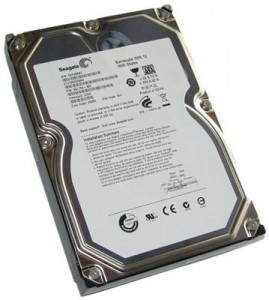Harddisk Dimensions
The sizes of hard disks are often judged by how much data they can store rather than the physical dimensions of the device. The largest hard disks today can store up to two terabytes of data. That is 2 trillion bytes (2,000 gigabytes).
Hard Disk Capacity
1 terabyte (TB) is equal to 1,000 gigabytes (GB). 1 gigabyte is equal to 1,000,000 megabytes (MB). 1 megabyte is equal to 1 billion (1,000,000,000) kilobytes (KB). This is equal to 1 trillion (1,000,000,000,000) bytes (B).
However some systems use the binary prefix so the increase is reported by 1024 and not 1,000. But for the sake of convenience, the sizes of hard disks are often rounded off to powers of 1,000.
Although 2 TB hard disks are currently the top of the line, most hard disks used are in the 500 GB range (few hard disks below 120 GB are sold nowadays).
The average rotation rate is 5,400 to 10,000 rpm. These hard disks have a transfer speed of 1 Gbits/s or greater. Some hard disks can move at 15,000 rpm.
Form Factors
Form factors came into being as  PCs grew and the need for hard disks increased. Before personal computers became popular, storage devices were as large as washing machines. The most common form factors are 3.5” and 2.5”. When looking at the size of hard disks, various types will be seen.
PCs grew and the need for hard disks increased. Before personal computers became popular, storage devices were as large as washing machines. The most common form factors are 3.5” and 2.5”. When looking at the size of hard disks, various types will be seen.
A 47 GB hard disk can have a form factor of 5.25” with 14 platters with a width of 146 mm. A disk with a similar width can be seen in some 19.3 GB drives. A 2 TB drive can have a form factor of 3.5” with a width of 102 mm.
Other types include 3.5” PATA, 102 mm, 750 GB; 2.5” SATA, 69.9 mm, 1 TB; 2.5” PATA, 69.9 mm, 320 GB; 1.8” SATA, 54 mm, 250 GB; 1.8” PATA/LIF 54 mm, 240 GB; 1.3”, 43 mm 40 GB; 1” (CFII/ZIF/IDE-Flex), 42 mm, 20 GB and 0.85”, 24 mm, 8 GB.
Types of Hard Disk Form Factors
As the sizes of hard disks evolved, the form factors changed. During 1979, the 8 inch appeared (9.5 in × 4.624 in × 14.25 in (241.3 mm × 117.5 mm × 362 mm). In 1980, Seagate came up with the 5.25 in, (5.75 in × 1.63 in × 8 in; 146.1 mm × 41.4 mm × 203 mm).
Another form factor came out in 1983 called the 3.5 in (4 in × 1 in × 5.75 in). The 2.5 in (2.75 in × 0.374–0.59 in × 3.945 in) first appeared in 1988. This size is used in several mobile devices. It is widely employed in game consoles.
The 1.8 in (54 mm × 8 mm × 71 mm) came out in 1993. It is used in music audio players. New 1 inch and 0.85 form factors have appeared. They are used in some mobile phones and other drives.
The size of hard disks will just keep on getting bigger. With data increasing on the Internet, the capacity of these devices are bound to expand and transfer rates go much faster.





